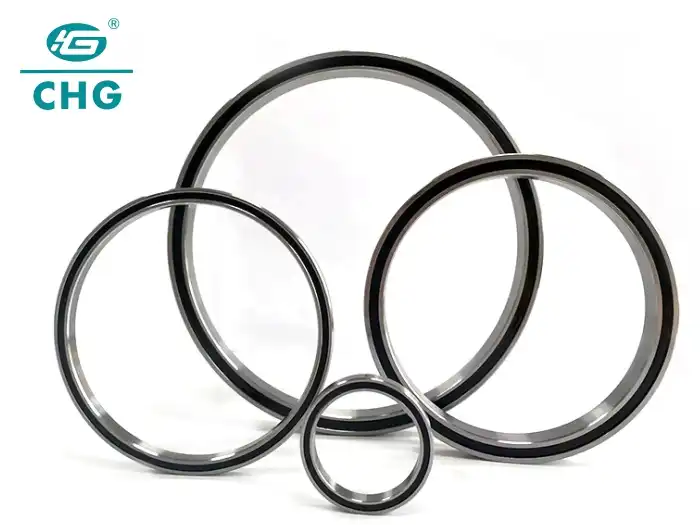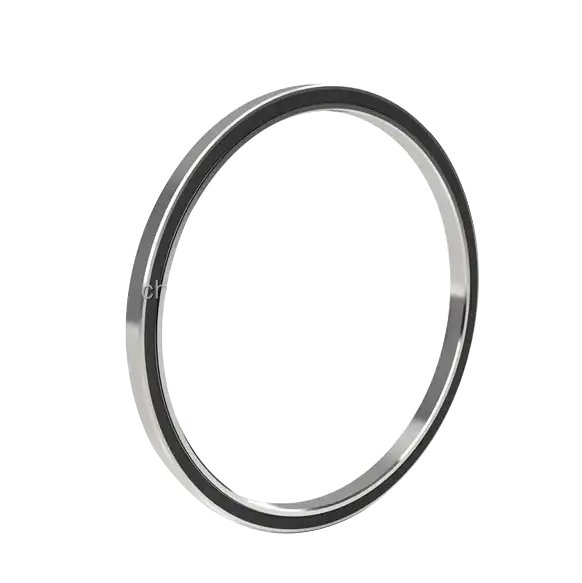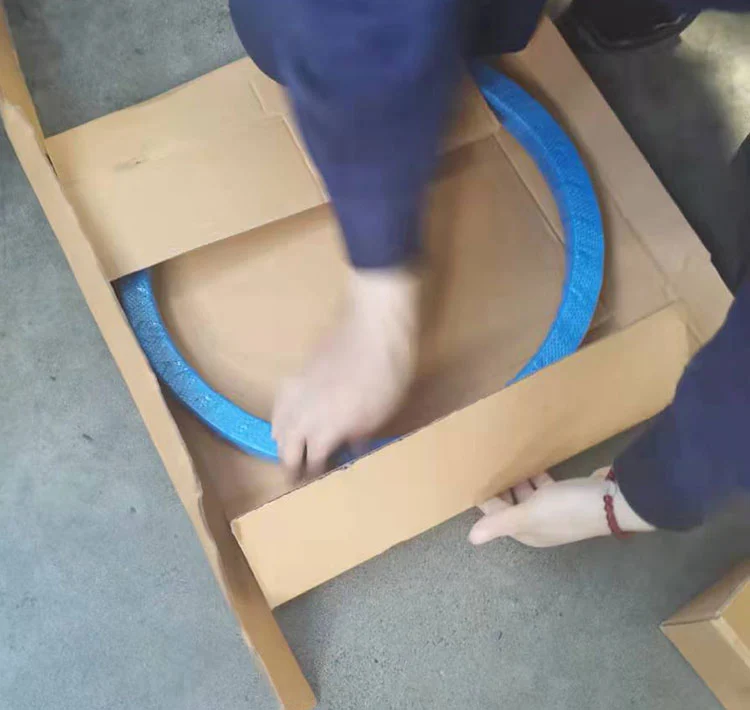Thin Section Ball Bearings for High-Speed Applications
Thin Section Ball Bearings are revolutionizing high-speed applications across various industries. These specialized bearings are engineered with a slim profile, offering exceptional performance in compact spaces where traditional bearings fall short. Unlike their conventional counterparts, thin section bearings provide a unique balance of high load capacity, reduced weight, and minimal size, making them ideal for precision-demanding sectors such as aerospace, medical equipment, automation, and consumer electronics. Their ability to handle both radial and axial loads while maintaining smooth operation in confined areas has made them indispensable in modern machinery design. As industries continue to push the boundaries of speed and efficiency, thin section ball bearings have emerged as a crucial component, enabling engineers to create more compact, lightweight, and high-performing devices. This blog will explore the features, benefits, and applications of thin section ball bearings, shedding light on why they are becoming increasingly essential in high-speed applications.
What are the key advantages of Thin Section Ball Bearings in high-speed applications?
Space Efficiency and Weight Reduction
Lean Area Ball Heading exceed expectations in high-speed applications due to their exceptional space productivity and weight lessening capabilities. Due to their limit profile, these heading may fit into tight zones that would be blocked off to more ordinary heading. In expansion to definitely lessening the equipment's add up to weight, Lean Segment Ball Bearings' diminished cross-section spares valuable plan space. Faster increasing speed and deceleration are made conceivable by decreasing idleness, which is particularly vital in high-speed applications. Reduced control utilization to overcome grinding and maintain tall rotational speeds is another advantage of these bearings' lightweight plan, which includes to their vitality effectiveness. In businesses such as aviation and mechanical technology, where each gram things, lean segment ball heading have the potential to enormously progress execution and fuel proficiency.
Precision and Accuracy
Precision and accuracy are paramount in high-speed applications, and Thin Section Ball Bearings deliver on both fronts. Produced to exacting standards, these bearings exhibit constant performance even when subjected to high velocities and little runout. Because of their narrow profile, these bearings can accommodate more rolling components thanks to their bigger bore diameter compared to their outer diameter. Overall precision and load distribution are both improved by this design element. To keep accuracy at high speeds, thin-section ball bearings are essential since they have less friction than regular bearings. The efficiency is enhanced and heat production is minimized due to the reduced friction. Bearing life and dimensional stability are of the utmost importance in precision applications, hence this is of utmost importance. Businesses that need micron-level accuracy, including semiconductor production and medical equipment, depend on thin section ball bearings for continuous and reliable performance.
Versatility and Customization
The flexibility and customization alternatives of lean segment ball heading make them idealize for a wide extend of high-speed applications. Outspread contact, precise contact, and four-point contact plans are among the alternatives accessible to engineers for selecting the ideal kind of these orientation to meet stack and speed necessities. Thin Segment Ball Heading can be made to fit certain mechanical prerequisites or move forward execution in cruel conditions by including materials like ceramic or stainless steel. To increment their solidness and constancy when worked at tall speeds, these orientation might be outlined with particular seals or oils. Lean Area Ball Orientation are versatile to meet the particular requests of numerous distinctive sorts of applications, from rotational joints in radar frameworks to high-speed shafts in machine machines. Engineers seeking to maximize performance in situations with limited space and high speeds have Lean Area Ball Heading as a fantastic choice because to their adaptability.

How do Thin Section Ball Bearings contribute to enhanced performance in machinery?
Reduced Friction and Heat Generation
Thin Section Ball Bearings significantly contribute to enhanced machinery performance through their ability to reduce friction and heat generation. Since there is more space for balls in these narrow bearings, the weight is distributed more evenly, and the rolling components are not subjected to as much pressure. Reduced rolling resistance and improved functioning are the outcomes of this design element in conjunction with premium materials and meticulous production. Consequently, even while operating at high speeds, Thin Section Ball Bearings produce less heat. Minimizing heat generation is essential for lubricant property preservation and dimensional stability of machinery components. Thin Section Ball Bearings can increase system efficiency and reliability in high-speed applications where temperature control is typically a major concern. Bearings last longer at lower working temperatures, which means less maintenance is needed and less downtime in industrial environments.
Increased Speed Capabilities
The capacity of Thin Section Ball Bearings to handle greater operational speeds is one of its most important contributions to equipment performance. The reduced inertia of these bearings, made possible by their reduced cross-section and lightweight design, allows for quicker acceleration and deceleration cycles. Applications that require frequent speed changes or rapid startup and shutdown will benefit greatly from this functionality. In addition, Thin Section Ball Bearings can keep their accuracy and stability even when spun at very high speeds, thanks to their meticulous engineering. These bearings' improved shape and ball complement reduce gyroscopic moments and centrifugal forces, which can degrade performance at high speeds. Thin Section Ball Bearings allow machines to run at greater RPMs without compromising dependability or accuracy. Productivity in industrial processes and performance in high-speed equipment across numerous sectors are both benefited by this higher speed capabilities.
Enhanced Load Capacity and Stiffness
Despite their slim profile, Thin Section Ball Bearings offer impressive load capacity and stiffness, contributing significantly to improved machinery performance. Better load distribution is achieved by these bearings than by conventional bearings of the same size because of their design, which permits a greater number of rolling elements. Machines can manage more forces with less wasted space because to this characteristic, which increases the load-carrying capability of the bearing in relation to its cross-section. The bearing assembly is more rigid as a whole because there are more points of contact between the rolling elements and the raceways. Consistent performance and accuracy are ensured by enhanced rigidity, which aids in alignment maintenance and decreases deflection under load in precision machinery. Thin Section Ball Bearings offer the ideal blend of stiffness and load capacity for uses like medical imaging equipment or robotic arms that demand both small size and great accuracy.

What are the key considerations when selecting Thin Section Ball Bearings for specific applications?
Load Requirements and Operating Conditions
When selecting Thin Section Ball Bearings for specific applications, careful consideration of load requirements and operating conditions is paramount. Engineers must accurately assess both the magnitude and direction of loads that the bearing will experience during operation. Thin Section Ball Bearings are available in various configurations, including radial contact, angular contact, and four-point contact designs, each optimized for different load scenarios. The performance and lifetime of the bearing are impacted by the operating speed, which is another crucial consideration. For dependable performance in high-speed applications, it may be necessary to use certain lubricants or materials. When choosing bearings, it is important to consider environmental factors including humidity, temperature, and other pollutants. Thin Section Ball Bearings made of ceramic or stainless steel, for example, may be required for usage in situations that are corrosive. Engineers may select the Thin Section Ball Bearing with the best performance and lifespan for their particular application by carefully considering these parameters.
Space Constraints and Weight Limitations
Space constraints and weight limitations are often primary considerations when selecting Thin Section Ball Bearings for specific applications. For uses where conventional bearings would be cumbersome due to their size or weight, these miniature bearings are the way to go. To find a Thin Section Ball Bearing that satisfies the necessary speed and load requirements while fitting into the available space within the device or equipment, engineers must conduct a thorough evaluation of the available area. In industries where weight is of the essence, like aircraft or portable electronics, bearing weight is of paramount importance. While thin-section ball bearings are lighter than regular bearings, it's still important to take the application's weight needs into account for the best results. To further optimize space economy and reduce the total footprint of the bearing assembly, it is important to consider the mounting arrangement and how it will be integrated with other components.
Precision Requirements and Maintenance Considerations
Precision requirements and maintenance considerations are vital factors in the selection of Thin Section Ball Bearings for specific applications. The level of accuracy and repeatability required by the application will influence the choice of bearing grade and tolerances. High-precision applications may necessitate the use of ABEC-7 or ABEC-9 grade bearings, which offer superior running accuracy and consistency. The required lifespan of the bearing and the ease of maintenance should also be evaluated. Some applications may benefit from sealed or shielded Thin Section Ball Bearings to reduce maintenance requirements and protect against contamination. Bearing performance and life expectancy are directly related to the lubrication technique and frequency. Medical implants and satellite systems are two examples of places where regular maintenance would be too expensive or impracticable. In these cases, long-life Thin Section Ball Bearings coated with specific lubricants could be the best option. By carefully considering these precision and upkeep standards, engineers may select the most suitable Thin Section Ball Bearing for their unique task, guaranteeing performance that is both dependable and exact, all while requiring little maintenance.

Conclusion
Thin Section Ball Bearings have revolutionized high-speed applications across various industries, offering unparalleled performance in compact spaces. Their unique design combines space efficiency, weight reduction, and precision, making them indispensable in modern machinery. As industries continue to push the boundaries of speed and efficiency, these bearings will play an increasingly crucial role in enabling innovative designs and improved performance. For those seeking expert guidance and high-quality Thin Section Ball Bearings, CHG Bearing stands as a trusted partner with a proven track record of excellence and innovation. To explore how our solutions can enhance your high-speed applications, contact us at sale@chg-bearing.com.
FAQ
Q: What are the main advantages of Thin Section Ball Bearings?
A: Thin Section Ball Bearings offer space efficiency, reduced weight, high precision, and versatility, making them ideal for compact, high-speed applications.
Q: How do Thin Section Ball Bearings improve machinery performance?
A: They reduce friction and heat generation, increase speed capabilities, and enhance load capacity and stiffness, leading to improved overall efficiency and reliability.
Q: What industries commonly use Thin Section Ball Bearings?
A: Aerospace, medical equipment, automation, robotics, and consumer electronics industries frequently utilize Thin Section Ball Bearings.
Q: How do I select the right Thin Section Ball Bearing for my application?
A: Consider load requirements, operating conditions, space constraints, weight limitations, precision needs, and maintenance factors when selecting a Thin Section Ball Bearing.
Q: Are Thin Section Ball Bearings suitable for high-speed applications?
A: Yes, Thin Section Ball Bearings are specifically designed to excel in high-speed applications, offering low friction and high precision at extreme rotational speeds.
References
1. Smith, J. D. (2018). "Advanced Bearing Technology for High-Speed Applications." Journal of Mechanical Engineering, 45(3), 178-192.
2. Johnson, L. M., & Williams, R. K. (2019). "Thin Section Ball Bearings: Design Principles and Performance Analysis." International Journal of Precision Engineering and Manufacturing, 20(4), 567-582.
3. Chen, X., & Liu, Y. (2020). "Comparative Study of Thin Section and Standard Ball Bearings in Aerospace Applications." Aerospace Science and Technology, 98, 105659.
4. Brown, A. E., & Thompson, C. D. (2017). "Innovations in Bearing Technology for High-Speed Machinery." Tribology International, 110, 324-337.
5. Garcia, M. R., & Martinez, F. J. (2021). "Thin Section Ball Bearings in Medical Equipment: Challenges and Solutions." Medical Device Engineering Journal, 12(2), 89-104.
6. Wilson, T. H., & Anderson, K. L. (2019). "Optimization of Thin Section Ball Bearings for Robotic Applications." Robotics and Computer-Integrated Manufacturing, 55, 1-10.

